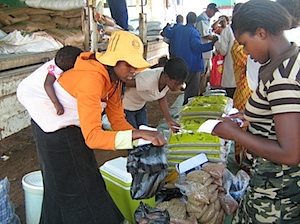My good friend Cesar Azurdia has alerted me to the publication of the book Guatemala y su Biodiversidad. Chapter 9 focuses on agricultural biodiversity. There’s a lot of great stuff on homegardens, crop wild relatives, effects of climate change etc., all subjects very dear to our heart here.
Plant breeding resources brought together
The Global Partnership Initiative for Plant Breeding Capacity Building (GIPB) has just released a new version of its Knowledge Resource Center for plant breeders:
One of the main objectives of GIPB is the establishment of a Knowledge Resource Center, including a shared information portal covering key areas such as training needs and opportunities, access to conventional and molecular breeding technologies and genetic resources, general information on breeding programmes and useful links.
Check it out.
Further dispatches from germplasm database hell
In which our hero Jeremy tries to trace germplasm collected by Vavilov, and is disappointed.
Historic botanic garden criminally overlooked
Well it didn’t take long for someone to point out to me that I’d left out an important site from my list of agrobiodiversity attractions around Montpellier. That’s of course the beautiful and historic botanic garden, one of the oldest in France. I’m happy to rectify the omission.
Input fairs: the view from the ground
One of the FAO’s preferred responses to food emergencies is the Input Trade Fair. Farmers receive a voucher, which they can exchange for seeds and other inputs that they need for a better harvest. In 2007, for example, 20,000 government-selected families in central and eastern Swaziland received vouchers that they could spend at one of 25 Input Trade Fairs. Earlier this year, FAO described these fairs as “winners”. But as the 2008 planting season gets under way, the news from Mbabane is not good.
 A report carried by IPS says that Swazi Input Fairs [are] Falling Short. Far fewer farmers have received vouchers this season. In the wake of rising prices the vouchers are not enough to purchase all the inputs needed. More vendors have entered the market, cutting down on sales for existing vendors. But most worrying of all, according to the report most of the subsistence farmers who have benefited from the scheme are no nearer being able to stand on their own feet than they were before the scheme started. Some, it is said, have no real interest in farming. They are just hungry, and wash the pesticidal dressings off the seeds before cooking and eating them. Many farmers refuse to switch away from maize, which needs far more water than crops such as sorghum.
A report carried by IPS says that Swazi Input Fairs [are] Falling Short. Far fewer farmers have received vouchers this season. In the wake of rising prices the vouchers are not enough to purchase all the inputs needed. More vendors have entered the market, cutting down on sales for existing vendors. But most worrying of all, according to the report most of the subsistence farmers who have benefited from the scheme are no nearer being able to stand on their own feet than they were before the scheme started. Some, it is said, have no real interest in farming. They are just hungry, and wash the pesticidal dressings off the seeds before cooking and eating them. Many farmers refuse to switch away from maize, which needs far more water than crops such as sorghum.
While an on-the-spot report such as this one offers some insights, it does not indicate how Swaziland’s drought-stricken farmers could best tackle their problems. Maybe they need more extension help, to show them how to make better use of their inputs. Maybe they need radical changes in their methods. I was at a meeting in London on Wednesday where I saw a very short video called Greening the Desert. Geoff Lawton, of the Permaculture Research Institute of Australia, explained in tantalizing snippets how he had transformed a barren patch of Jordan into a flourishing orchard. No, I have not seen peer-reviewed results. But it seems worth trying elsewhere, and Swaziland could be a good place to do so.